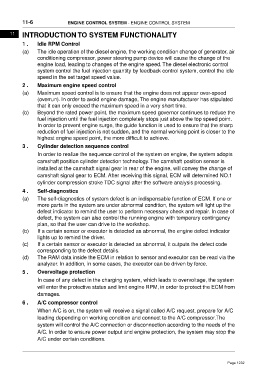Page 1232 - Foton Workshop Manual - Tunland (AT)
P. 1232
11-6 ENGINE CONTROL SYSTEM - ENGINE CONTROL SYSTEM
11 INTRODUCTION TO SYSTEM FUNCTIONALITY
1 . Idle RPM Control
(a) The idle operation of the diesel engine, the working condition change of generator, air
conditioning compressor, power steering pump device will cause the change of the
engine load, leading to changes of the engine speed. The diesel electronic control
system control the fuel injection quantity by feedback control system, control the idle
speed in the set target speed value.
2 . Maximum engine speed control
(a) Maximum speed control is to ensure that the engine does not appear over-speed
(overrun). In order to avoid engine damage, The engine manufacturer has stipulated
that it can only exceed the maximum speed in a very short time.
(b) Beyond the rated power point, the maximum speed governor continues to reduce the
fuel injection until the fuel injection completely stops just above the top speed point.
In order to prevent engine surge, the guide function is used to ensure that the sharp
reduction of fuel injection is not sudden, and the normal working point is closer to the
highest engine speed point, the more difficult to achieve.
3 . Cylinder detection sequence control
In order to realize the sequence control of the system on engine, the system adopts
camshaft position cylinder detection technology. The camshaft position sensor is
installed at the camshaft signal gear in rear of the engine, will convey the change of
camshaft signal gear to ECM. After receiving this signal, ECM will determined NO.1
cylinder compression stroke TDC signal after the software analysis processing.
4 . Self-diagnostics
(a) The self-diagnostics of system defect is an indispensable function of ECM. If one or
more parts in the system are under abnormal condition, the system will light up the
defect indicator to remind the user to perform necessary check and repair. In case of
defect, the system can also control the running engine with temperary contingency
plan, so that the user can drive to the workshop.
(b) If a certain sensor or executor is detected as abnormal, the engine defect indicator
lights up to remind the driver.
(c) If a certain sensor or executor is detected as abnormal, it outputs the defect code
corresponding to the defect details.
(d) The RAM data inside the ECM in relation to sensor and executor can be read via the
analyzer. In addition, in some cases, the executor can be driven by force.
5 . Overvoltage protection
In case of any defect in the charging system, which leads to overvoltage, the system
will enter the protective status and limit engine RPM, in order to protect the ECM from
damages.
6 . A/C compressor control
When A/C is on, the system will receive a signal called A/C request, prepare for A/C
loading depending on working condition and connect to the A/C compressor.The
system will control the A/C connection or disconnection according to the needs of the
A/C. In order to ensure power output and engine protection, the system may stop the
A/C under certain conditions.
Page 1232

